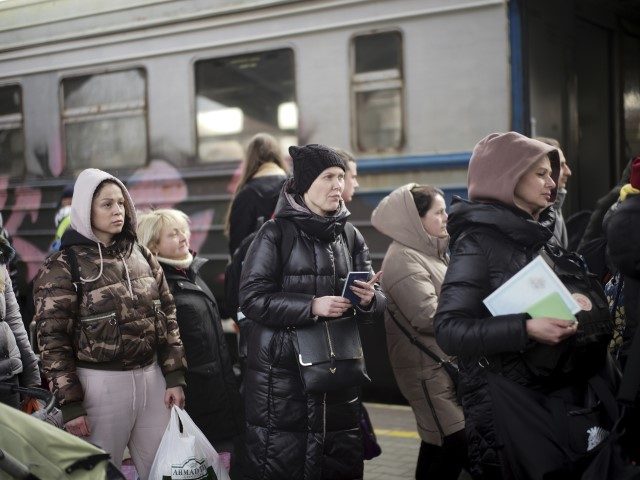Univisión journalist Jorge Ramos took a moment on Wednesday, reporting from Poland, to lament that the wave of tens of thousands of Ukrainian refugees on the border fleeing the Russian military assault on that country were not wearing sanitary masks.
Russian leader Vladimir Putin announced an operation last week to depose the Ukrainian government and “de-Nazify” the country. The Russian government has repeatedly referred to Ukrainian President Volodymyr Zelensky, the first Jewish president of the country, as a “Nazi.”
Univisión sent Ramos to the Polish-Ukrainian border – and, later, into Ukraine – to cover the war. Ramos observed on Wednesday that the refugees fleeing Russian bombardment did not appear concerned about the Chinese coronavirus pandemic.
“I know it’s a bit complicated, but think about the following,” Ramos said, according to a translation by Media Research Center Latino Director Jorge Bonilla. “We are in a war, several meters away in Ukraine, and we are in the midst of a pandemic and if you notice – the majority of Ukrainians arriving here [Poland] are not wearing a mask.”
“This is to say: the importance of survival is far above any other types of concerns,” Ramos observed:
"…we are in the midst of a pandemic and, if you notice, the majority of Ukrainians arriving here (Poland) are not wearing a mask." Univision's @jorgeramosnews, at a train station along the Poland-Ukraine border. pic.twitter.com/rQCupiCjR0
— Jorge Bonilla (@BonillaJL) March 2, 2022
The Russian military’s full-scale assault on the country – which Putin claimed was a defensive measure to protect eastern Ukraine but has veered deep into the heart of the country and into Kyiv, the national capital – turned a week old on Thursday. The United Nations reported on Thursday that the number of refugees fleeing the war had already reached one million, fueled by Russia’s focus on targeting densely populated metropolitan centers like Kyiv, Kharkiv, and Mariupol.
Ramos, in Ukraine, reported on Thursday that the civilian mobilization Zelensky ordered at the start of the Russian military operation, fueled by his government handing out free firearms to anyone interested in fighting Russians, was well underway.
“In many places, like this one, the people are making barricades with trees, tires, and sandbags to detain, if necessary, the entry of Russian vehicles,” Ramos observed.
Ya estamos dentro de Ucrania. En muchos poblados, como este, la propia gente crea barricadas con árboles, llantas y bolsas de arena para detener, en caso necesario, la entrada de vehículos rusos. pic.twitter.com/qpURTk7xRt
— JORGE RAMOS (@jorgeramosnews) March 3, 2022
Zelensky’s choice to stay in the country and order every citizen to take up arms against Russia has proven popular, according to a poll released this week. The Ratings Sociological Group found that 91 percent of Ukrainian respondents approved of the president – an increase of about 60 percentage points from his approval ratings before the war.
Zelensky’s handling of the coronavirus pandemic had severely tarnished his image prior to the shift in public interest towards the war with Russia. The president admitted in a New York Times column in May 2020 that the pandemic had severely disrupted his plans to focus on ending the eight-year Russian invasion of Ukraine – the same one that escalated significantly last week.
“Of course, I recognize that the pandemic has disrupted everything. Social distancing goes hand-in-hand with political distancing. The crisis has forced many countries to focus first on their domestic problems,” Zelensky wrote at the time. “This is understandable, but in an age of transnational crises that don’t stop at borders, we must not lose the focus on the tremendous positive potential of international cooperation.”
Zelensky himself was hospitalized with a coronavirus infection in November of that year and later led an ambitious vaccination campaign that included what the Washington Post described as “scary” public service announcements featuring graphic images of purported coronavirus patients and insisting to citizens that they could die if unvaccinated.
Zelensky’s approval ratings and citizens’ general optimism about Ukraine cratered as the pandemic wore on. As the Wilson Center recalled:
Volodymyr Zelensky enjoyed unusual popularity for more than two years. But the general optimism about the direction Ukraine was heading—the uplift Zelensky had brought to Ukrainians in 2019—had already evaporated by 2020: from polls showing 52 percent of Ukrainians optimistic and 18 percent pessimistic in September 2019, the mood shifted to 23 percent optimistic and 60 percent pessimistic in March 2020, and since then pessimism has prevailed.
In July 2020, the number of those who did not trust Zelensky exceeded the number of those who still believed in him (51 percent versus 43 percent).
Zelensky also faced thousand-strong protests against vaccine mandates and other coronavirus restrictions in Kyiv in November:
Zelensky, nonetheless, remained the most trusted politician on a national level in Ukraine, polls showed as recently as July.
A Rating Sociological Group poll from July found that 45 percent of Ukrainians trusted him while more than a half (52 percent) did not. In contrast, as many as 72 percent of respondents said they did not trust Zelensky’s predecessor, Petro Poroshenko, and only 25 percent expressed trust in Yuriy Boiko, Zelensky’s rival in the 2019 presidential election.
Only 27.7 percent of respondents in that poll said they would vote for Zelensky if the election were today – low, but still higher than for any other politician. The second most popular, Poroshenko, would have received 13.4 percent of the vote, according to the poll.

COMMENTS
Please let us know if you're having issues with commenting.